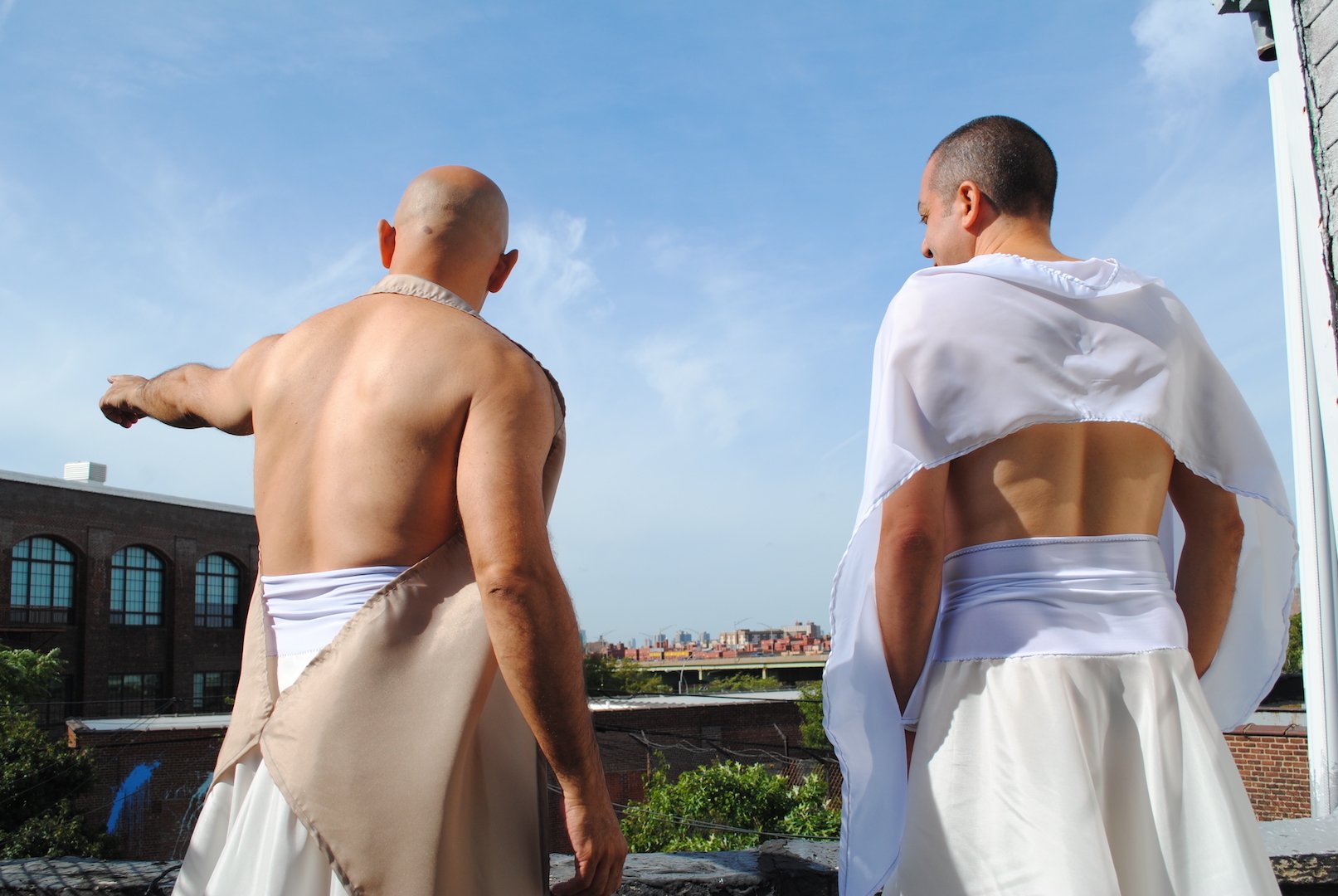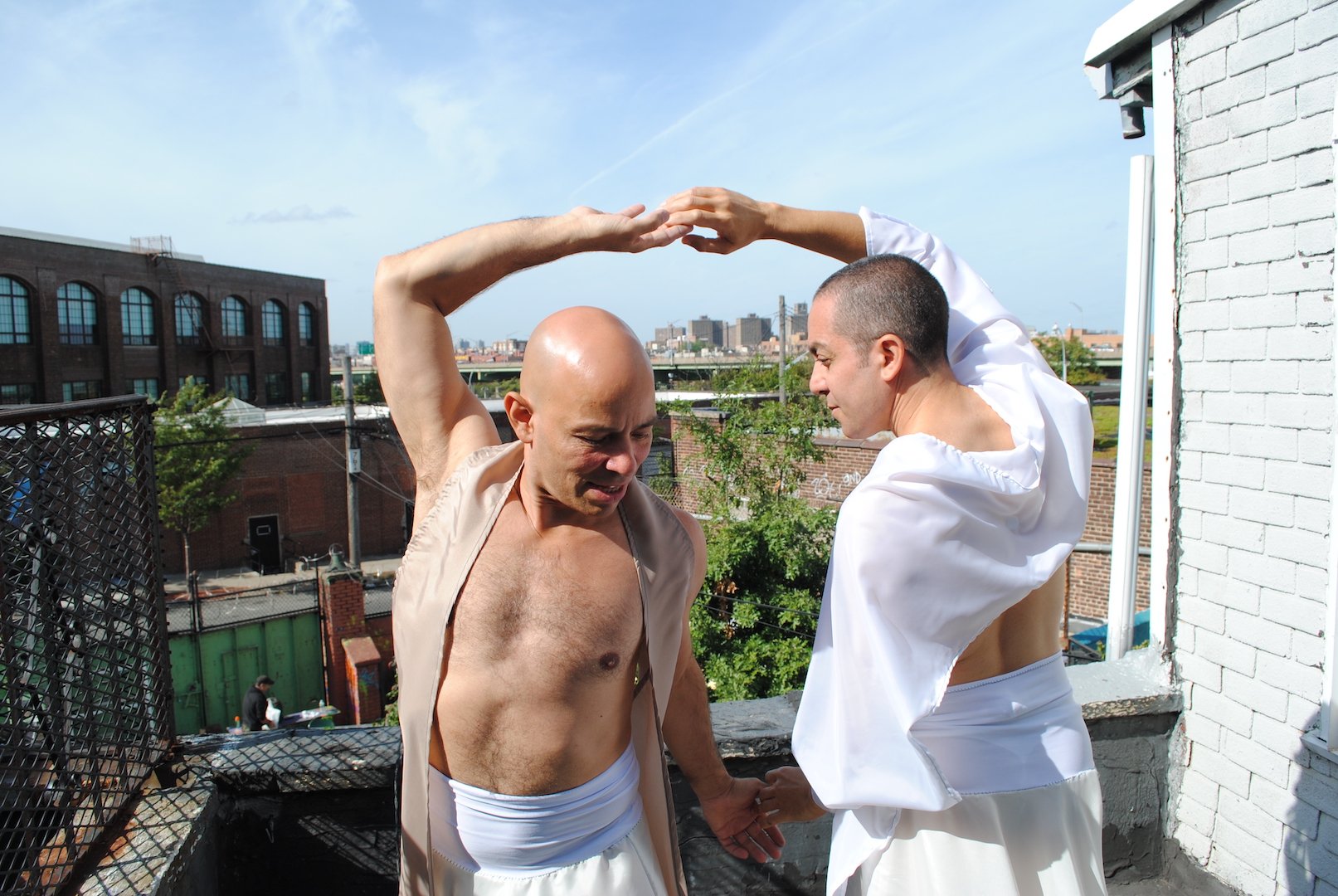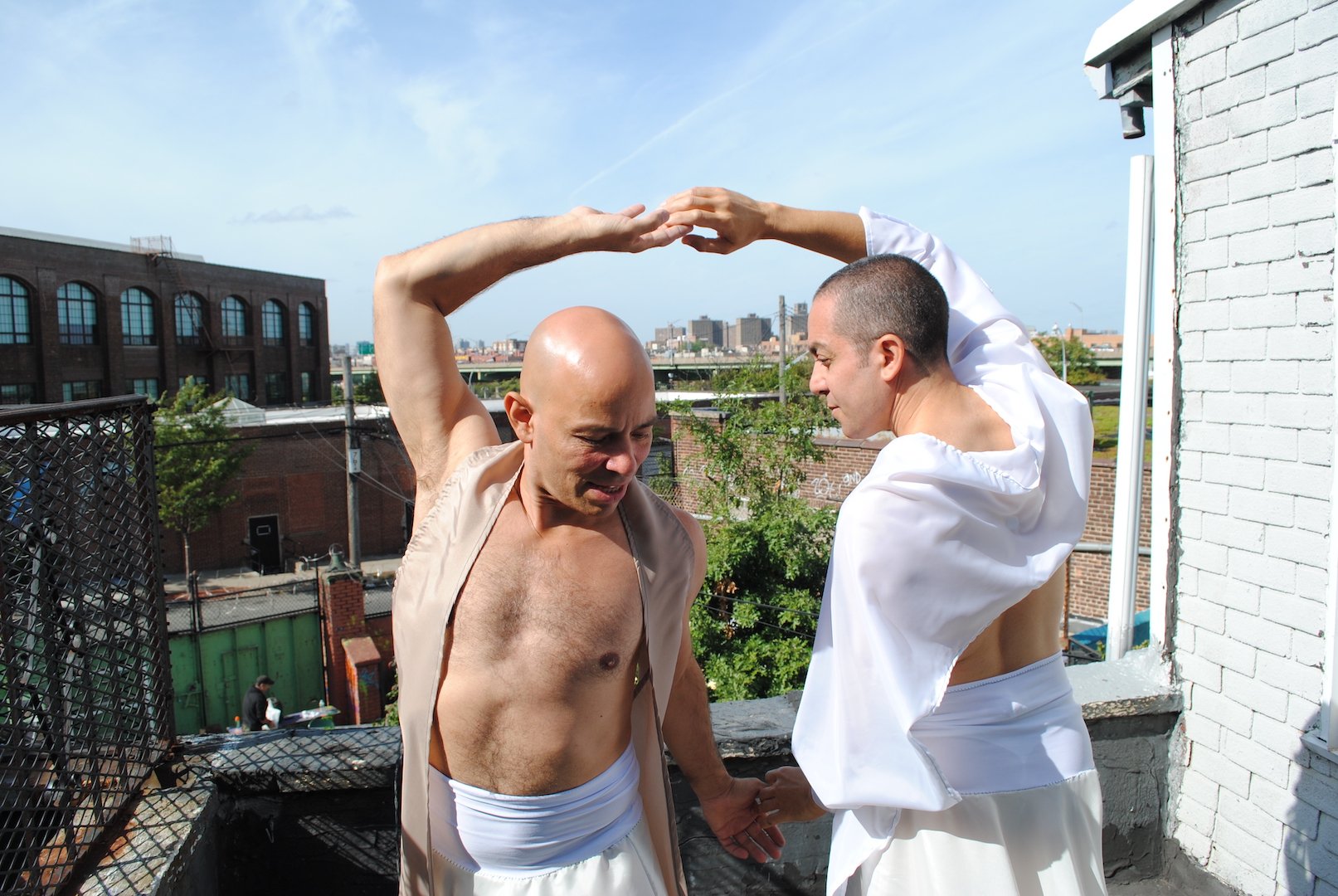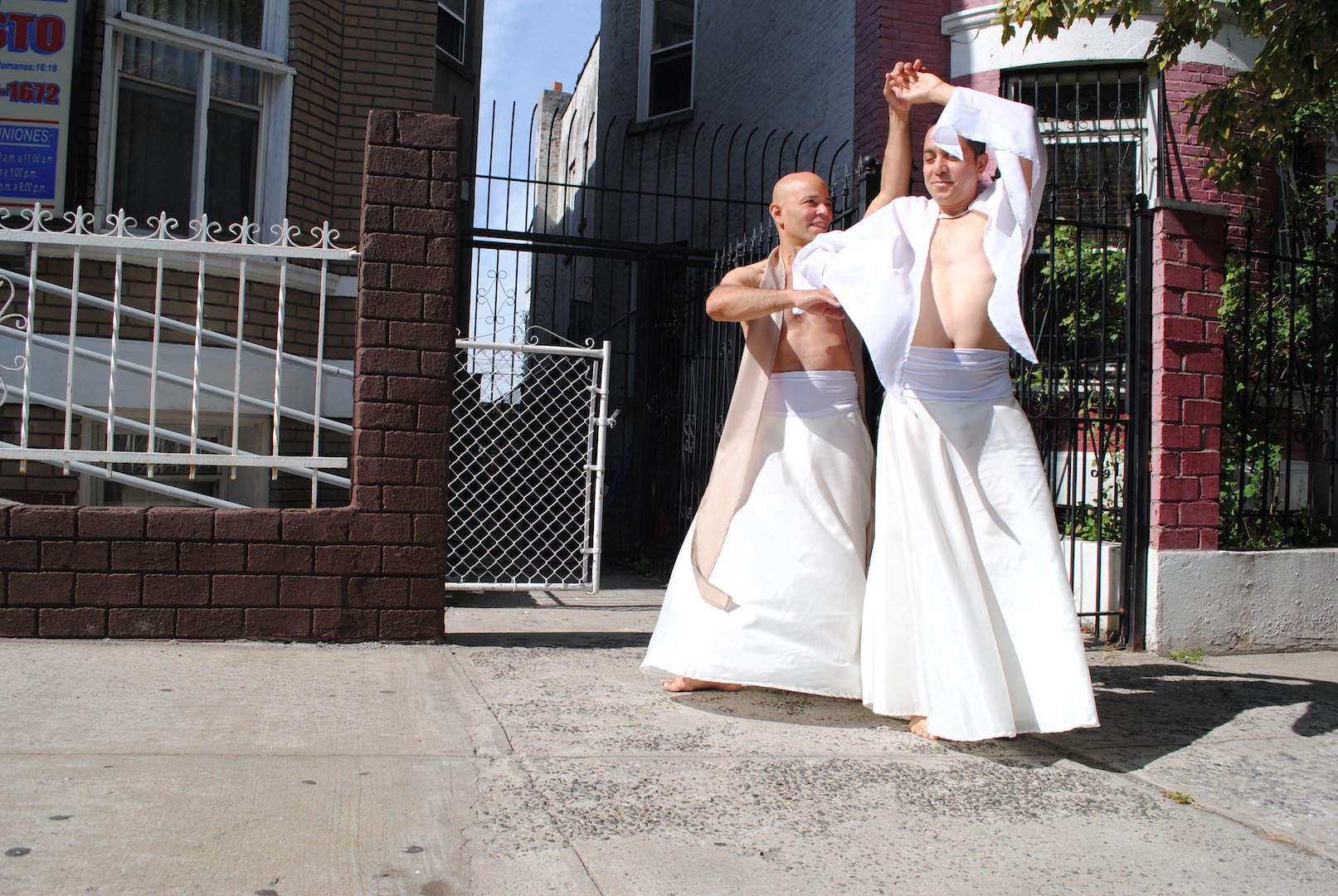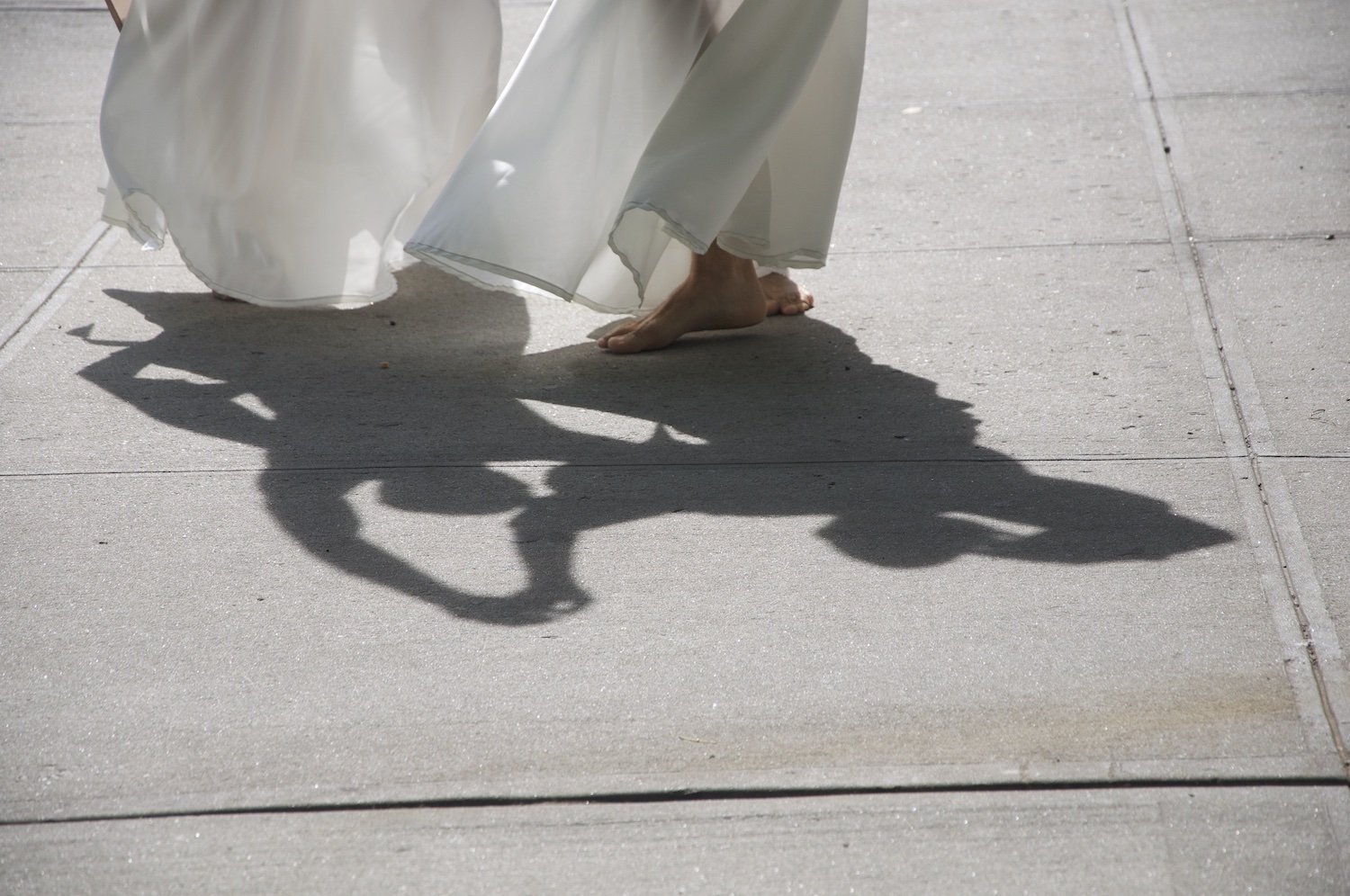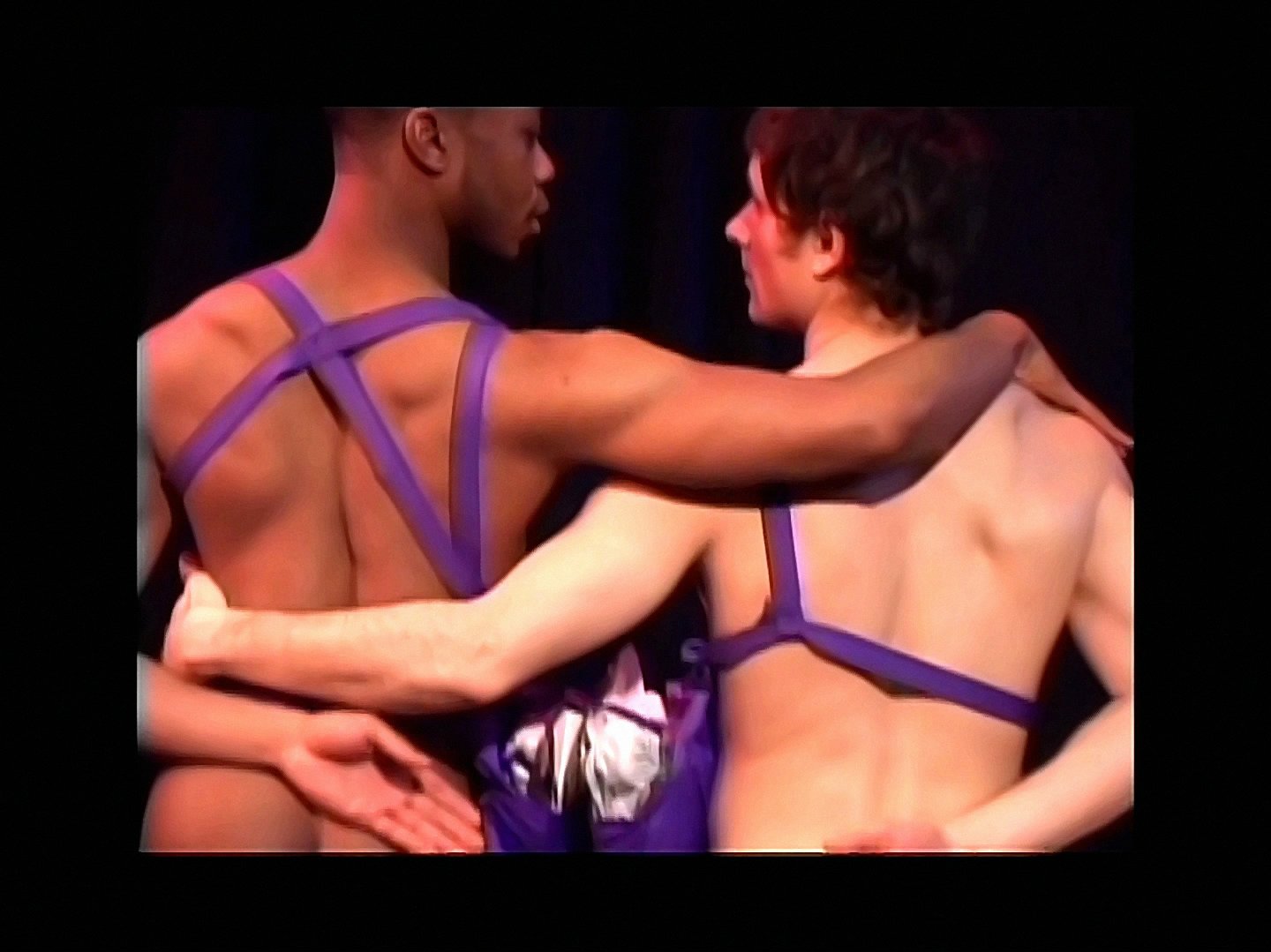Arthur Avilés and Nicolás
Amor Raro and Other Heart-Shaped Islands
Nicolás Dumit Estévez: I am excited about engaging in a dialogue in which dance is our focal point. Would you be up for allowing this topic to be the spirit moving our thoughts and shaping our words during this exchange?
Arthur Avilés: Yes. I love to talk about dance even though sometimes for me it can be a tough topic to pin down in language. I love the challenge of working at that.
NDE: I recall meeting you at THE POINT, an arts organization in Hunts Point, the Bronx, in 2001. I was looking for a place where I could take waltz classes in preparation for Recuerdo de Mis Quince, the performance that I was developing as part of my residency at P.S.1/MoMA. Is this around the time when you decided to move back to the area after years of touring the globe as a dancer with Bill T. Jones? Why the South Bronx and why Hunts Point?
AA: I came back to the Bronx from being away from it for 15 years. I returned in 1996. I spent my teen years here then went off to Bard College, Upstate New York, at 18. Right after receiving my bachelor of fine arts degree in theater/dance I joined Bill T. Jones/Arnie Zane Dance Company and toured for eight years. You ask why the South Bronx. Well, I never really thought of it as the South Bronx. I moved to Hunts Point at the invitation of Mildred Ruiz-Sapp and Steven Sapp, two of the founders of THE POINT who also went to Bard and so I felt an affinity to that and the fact that I would be going back to a place that seemed familiar to me. I left the Bill T. Jones/Arnie Zane Dance Company in order to explore new horizons. THE POINT was new and ready for a fresh crew of artists to give to it. I also saw a great opportunity to explore my art. There was space and eyes that were new to the kind of dance I practiced and so I wanted to share that knowledge I received. I must admit I felt the Bronx I grew up in missed out on what I received outside of it and felt I could come back and share what I would consider some good stuff with a group of people (like myself from the past) who might not receive that kind of training so easily. I started the dance program at THE POINT and had a great time working with the kids there.
NDE: Hunts Point is generally portrait by the media as a neighborhood of low-income housing, auto repair shops, and strip clubs like the infamous Badabing. As an insider to the place, I am aware that, while these might be some of the outer layers that outsiders can access, there is a deep sense of belonging to this tightly-knit community. There is also a significant LGBTQI presence and history in the area. How did you become friends with and later part of the Hunts Point family?
AA: Well, as soon as Mildred and Steve invited me, I moved into an apartment right next to the community center. I still live in this place now. Back then, I didn’t take into consideration as to whether the Bronx had an infamous representation. I guess I knew it but that wasn’t at the top of my consciousness. I was at the beginning of starting a dance company. Besides, the ghetto was always familiar to me. I was born in a Jamaica, Queens, a project where the Savage Skulls gang hung out in our playground and I personally never felt anything was wrong with that. Maybe all that action was happening over my head and I was too busy playing. Yeah, my teen years spent in the Bronx had a similarity so I see this environment as natural to me. I grew up here.
As far as the LGBTQI community is concerned I have met some really wonderful friends like writer and poet Sydney Boone and Hunts Point resident Ruben Thomas who started filming our performances. I met my then lover and partner, Bronx native writer, Charles Rice-Gonzalez. Together we built our own space for creativity called BAAD!, the Bronx Academy of Arts and Dance, now in its 16th year, with its mission to present works that are empowering to women, people of color and the LGBTQI communities right here in the Bronx. Since then I can say I’m proud to be a part of a community getting stronger.
NDE: For decades, Hunts Point has experienced racist, classist, and sexist blows on behalf of the “City.” This is obvious in how the place has become a dumping ground for all of that which Manhattan and gentrifying neighborhoods in Brooklyn and Queens do not want in their backyards: from jails to trash incinerators. What is the role of dance in counteracting such brutal assaults on one’s individual and collective body and spirit?
AA: One of the things I can say about that is that dance helps to activate endorphins and that it is difficult for anyone to argue with that. With dance we are alive, moving our bodies to the things we can believe in. We can also excite others to help us to celebrate the freedom we can feel in being ourselves.
NDE: In 2011, my mentor and friend Linda Mary Montano invited me to perform with her HOPE, an action through which we traveled through the Bronx asking people to inscribe their hopes directly on the clothing that we were wearing. Hunts Point was one of the neighborhoods we visited. With HOPE still fresh in my mind, I was wondering if you can elaborate on any dance work that you might have done locally around the subject of love: self-love, same-sex love, or community-wide love?
AA: starting back in 1998 I created a performance series that I called A Community that Dances Together… This was largely dance-based, involving many sects of the community. It was multigenerational and also expressed many subject matters; from the practice of Wicca to queer pride. It was open to anyone who wanted to come together in the sprit of doing just that. More than 30 community members showed pride in who they were. It was a show for the community and by the community. The diversity was a joy to behold.
NDE: I can still picture today the audiences peeking through the glass door at two men kissing at El Museo del Barrio’s offices. How was your piece This Pleasant and Grateful Asylum (TPAGA) born?
AA: Yes. In that setting that dance became a part of a particularly intriguing situation. Thank you for giving me such a strange platform to present my work. I loved experiencing the juxtaposition of lyrical naked dancers with their purple suspenders and holsters with the strict clean lines of the corporate walls of the offices at El Museo. The audience watched them tango in what could be a dream.
I wanted to create a dance that expressed the complexities of any given relationship. At that time, my boyfriend Charles Rice- Gonzalez and I had been in a relationship for two years. That relationship felt new and vibrant. I wanted to bring us together in a special way. I grabbed from such inspiring choreographers like Martha Graham, Steven Petronio, and Bill T. Jones, among others, to create a fantasy world with metaphors expressing how complicated it is to be two men in love with each other.
NDE: Who are you? I know that this sound like a generic existential question. What I am driving at are the public performances of sexualities, and notions of Puertorriqueñidad and Nuyoricanidad that your choreographies push one to grapple with.
AA: Yes! I will come at this simply and say that I am a gay New York-Rican who loves to dance and I run a performance space open to the community and I enjoy living in the Bronx. I feel that all my works have that spirit running through them.
NDE: My connection to dance comes from my upbringing in the Dominican Republic. Music is part of almost every activity people do on a daily basis. Dance is in my blood tissue. What about you?
AA: I think we grew up in similar cultures and feel the same way. When I went to Bard College I learned of a choreographer named Merce Cunningham and he explored dance as parallel to sound/music. The dances he creates are intentionally not created with music in mind. To a certain extent I have brought that philosophy in my work at times. I have heard it expressed that when one comes out of the womb one moves/dances, then one will cry/music as one enters the world.
NDE: Where is the Island, Puerto Rico, in your work, metaphorically speaking?
AA: The Island in my work is this sense of freedom and safeness I get when I am expressing the true essence of how I feel.
NDE: Your sexual identity is of key importance to your artistic practice. Has this been a strategic move to garner attention on pressing issues involving LGBTQI communities? If so, as a man of Puerto Rican background living in the South Bronx, how do you negotiate gayness with gay white, middle-class men who may not want to be associated with some of our trans or rara/o (my own non-academic interpretation of queer) neighbors?
AA: Thank you for the challenge of these statements and questions. What you propose here has a pretty provocative edge to it and I hope this answer can do it some kind of justice. As far as issues are concerned in my work, I stick to what is personal. I think that helps me to be in touch with my own reasons for creating a work of art. I happen to be a Queer Puerto Rican who lives in the Bronx and hope that I can stay aware of a truth you speak about, as it relates to that. I hope my awareness helps to calm my frustrations with power sects in the world.
NDE: A black friend and colleague asked the other day: Why is it that our bodies are targeted? Is it something we have that threatens whiteness? What is it? You have been using dance to spew back beauty to the outbound ugliness that threatens our communities: economic oppression (usually called material poverty), health issues, and political neglect, among others. How do you do that?
AA: What you are saying is so important and possibly not as complicated as others make it out to be. I think dance is a moment of vibrant peace and no matter what we are saying with the body when it moves, we know we are alive, regardless of personal circumstances and politics.
NDE: You are one of those rare artists who manage to keep nudity updated and relevant when getting naked in public is usually so boring. Can you comment on your strategies for doing so?
AA: Thank you for your kindness. I take what you are saying as a compliment. I try to make a conscious effort to give myself a reason as to why I am nude in any given dance. There are many reasons to show the nude body. Those reasons can range from vulnerability to pride. From shame to abuse. You name it. As many themes as there are in Shakespeare’s works there can be that many more reasons why a choreographer might express the unadorned body.
NDE: Why did you move the Bronx Academy of Arts and Dance to Westchester Square? I was saddened to see this iconic institution leave our neighborhood. How is this shift of location informing what you are doing as an artist and activist? Will you be able to continue the work that you initiated in Hunts Point?
AA: We moved before we had to move so that was very important to us. If we didn’t move we would have been priced out. We wanted to stay alive serving the Bronx. So without skipping a beat, which meant that our festivals stayed on schedule, we moved to the property of the Episcopal Church near Westchester Square. They had the perfect situation for us and we felt close enough for us not to lose our base supporters in Hunts Point. BAAD! is only eight stops north and I still live in Hunts Point. Our work in Hunts Point helped spark our movement and we don’t intend to stop any time soon!
NDE: Your devotion to our communities has been inspiring to me. Would you consider an invitation to Perform the Bronx together as part of Performing the Bronx, an initiative supported by the Bronx Council on the Arts that will launch at Casita Maria, and through which I ask neighbors like you to collaborate with me on an action triggered by our borough. Any initial ideas of how you would perform the boogie down Bronx, clothed or not?
AA: Yes this sounds like fun. I would love to partner dance with you coming down Hunts Point Ave. in cassock-like gowns, simply taking one hand then the next hand as we go underneath each others arms twirling around each other as we make our way on the sidewalk. We can start at Lafayette Ave. then end at Garrison Ave. I have 2 small video cameras.
NDE: I am excited about this. I am drawn to the simplicity of this action that you propose, as well as to the responses, vocal or silent (as in people’s heads), it will likely generate. Thank you, Arthur for talking with me. May the spirit of dance continue to move our feet and bless BADD!
AA: My pleasure for sure!
This piece was initially published with Caribbean Sexualities
Arthur Avilés is a Dancer/Choreographer who found dance at Bard college under Jean Churchill, Lenore Latimer, Albert Reid, Susan Osberg and Aileen Passloff. There he received a B/A in theater/Dance in 1987. He was a member of Bill T. Jones/Arnie Zane Dance Company from 1987 to 1995. In 1996 he created Arthur Avilés Typical Theatre a Bronx-based dance company whose mission is to create works that play on the margins of gay and Latino cultures. The company had its initial performance in 1996 and has been housed in the performance space BAAD!, the Bronx Academy of Arts and Dance, founded by Mr. Avilés and his partner-writer Charles Rice-Gonzalez. Mr. Avilés’ work ranges from theater to dance and the mix of the two mediums which sometimes include song, often taking the structure of stories from existing classics like Cinderella, the Ugly Duckling or even Martha Graham’s Seraphic Dialogue or José Limón’s The Moor’s Pavane, reconfiguring them in order to express the felt, actual and fantastical lives of Queer Latinos living in the ghetto. In May of 2015 he received an honorary doctorate from his Alma mater. http://www.baadbronx.org
Costume design for A Gentle Act of Men in Hunts Point: Lorenzo Walker / Website / IG
Arthur Avilés/ Related links: Website / Hemispheric Institute / Movement Research
About This Pleasant and Grateful Asylum:
This very special version of the dance duet This Pleasant and Grateful Asylum (1999) was performed in an office at the Museo de Barrio in New York City under the invitation of Nicolás Dumit Estévez, as a part of Action Actual. This festival featured artists’ explorations of off-limit areas where performative potential of backstage spaces and the creative possibilities of indoor cul-de-sacs could be experienced. Performed by Julio Alegría and Tim Cusack live, and by Neil Totton and Brandin Steffensen in the film edited by Peter Richards.
The presentation of This Pleasant and Grateful Asylum at El Museo del Barrio gave me a chance to bring film and physical bodies together in one setting, grounding a dance that, for me, happens in a dream. Working with the stern realities of a space meant to be a place where strict structure is applied to keep institutions running, we were confronted with the possibilities of what could seem like inappropriate though passionate and tender human interaction.
Nicolás Dumit Estévez has exhibited and performed at Madrid Abierto/ARCO, The IX Havana Biennial, MoMA, Printed Matter, Princeton University, El Museo del Barrio, Longwood Art Gallery/BCA, and Franklin Furnace, among others. He holds an MFA from Tyler School of Art, Temple University; and an MA from Union Theological Seminary in the City of New York. Publications include Pleased to Meet You, Life as Material for Art and Vice Versa (editor) and For Art’s Sake. Nicolás Dumit Estévez treads an elusive route that manifests itself performatively or through experiences where the quotidian and art overlap. Concurrently, this path has been informed by a strong personal interest in immigration, cultural hybridization and Estévez’s understanding of identity as a process always in flux. He hence approaches the concepts of home and belonging to the U.S. American context from the perspective of a Lebanese-Dominican, Dominican York who was recently baptized as a Bronxite: a citizen of the Bronx. While ephemeral by nature, Estévez’s work gains permanence through audio, photographs, props, drawings, rumors, embodied memories, costumes, websites, videos and publications.
Nicolás Dumit Estévez / Website / IG
Performing the Bronx is made possible with public funds from the Bronx Council on the Arts through the Department of Cultural Affairs’ Greater New York Arts Development Fund Program. Performing the Bronx has also received support from Casita Maria and the Bronx Academy of Arts, Dance (BAAD!) and Mothers on the Move (MOM).
